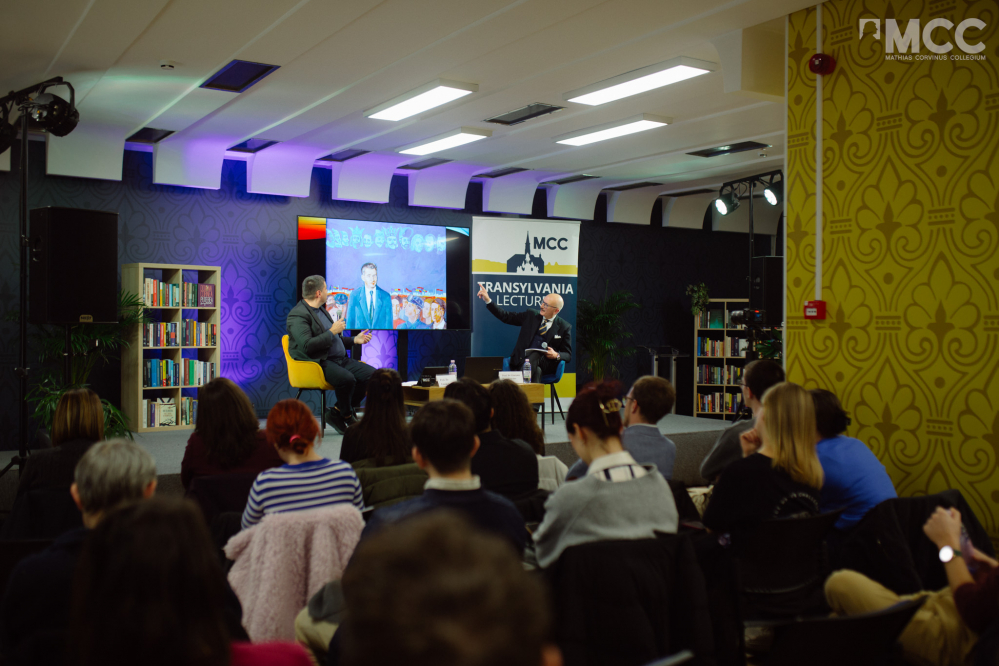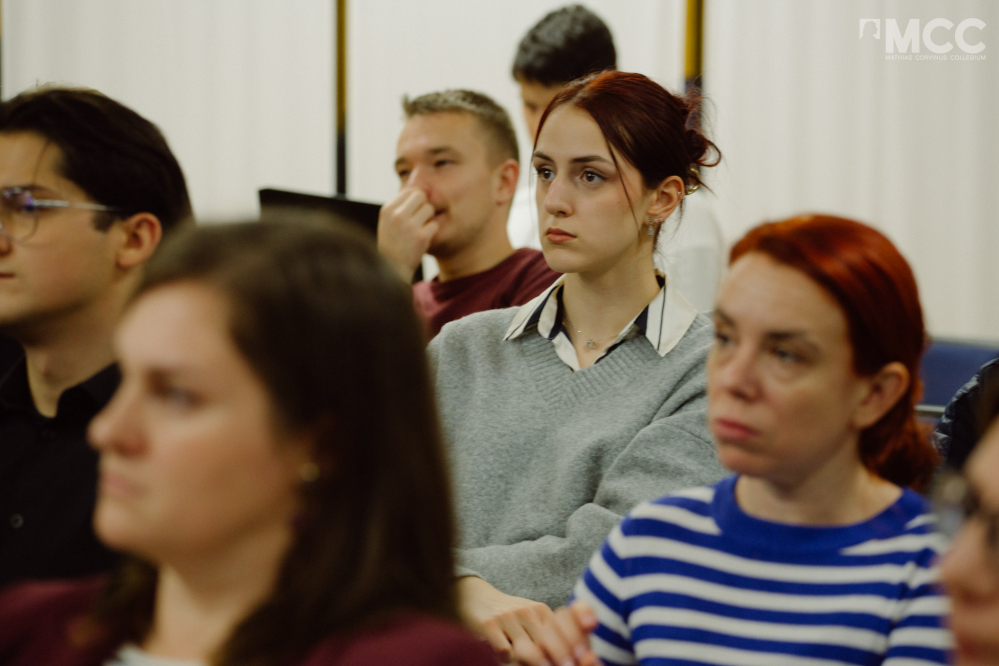Reading time: 6 minutes
On December 12th, the Transylvania Lectures series, organized by the Mathias Corvinus Collegium (MCC) hosted an engaging discussion exploring the intersection of totalitarianism, art, and law. Legal historian Prof. Dr. Giacomo Pace Gravina from the University of Messina and Sapientia University’s Prof. Dr. Emőd Veress shed light on how totalitarian regimes, particularly Fascist Italy under Mussolini and Communist Romania under Ceaușescu, utilized art and legal frameworks to control societal narratives and solidify power.
Art as Propaganda and Control in Fascist Italy
The lecture highlighted how authoritarian leaders craft their public personas and enforce ideological conformity through a dual strategy of cultural manipulation and legal reform. Mussolini’s regime exemplified this through monumental architecture, propaganda art, and legal codes rooted in Roman traditions, all aimed at legitimizing his authority and reviving the imagery of the Roman Empire. Through statues, mosaics, paintings, and films, Mussolini was portrayed as everything from a Roman emperor to a defender of Islam and a farmer leading Italy toward self-sufficiency. Each image contributed to a narrative of strength, unity, and imperial ambition.
Monumental architecture also became a vital tool for Fascist propaganda. Projects like the EUR district in Rome, designed for the 1942 Universal Exhibition (which was canceled due to World War II), symbolized a blend of modernist design and Roman imperial aesthetics. The Palazzo della Civiltà Italiana, often called the "Square Colosseum," embodied Fascist ideals of strength, order, and productivity while glorifying the labor force within a corporative system.
Fascism’s relationship with art extended beyond glorification to censorship and control. The regime labeled non-conforming artists as producers of "degenerate art," stifling creative expression that deviated from Fascist ideals. At the same time, works that aligned with the regime’s vision, whether through nationalistic themes or abstract representations of justice, work, and legislation, were celebrated and commissioned.
Fascist Italy also used archaeology and restoration to assert its imperial identity. Excavations of Roman sites in Mediterranean countries were presented as proof of Italy’s historical claim to dominance in the region. The restoration of ancient monuments, coupled with the construction of new ones, served to cement the Fascist regime’s ideological link to the glory of Rome.
The discussion underscored the role of art as a vehicle for legal messaging, often camouflaging the dismantling of democratic norms. The speakers delved into the reinterpretation of Roman law in Fascist Italy, which transformed legal symbols into instruments of authoritarian rule.
Mussolini’s regime relied heavily on the appropriation of Roman history and law to project continuity and legitimacy. Roman law became a rhetorical device to mask the erosion of democratic principles and the imposition of authoritarian control. The so-called “Mussolini Codes,” including the Civil Code of 1942, were framed as modern extensions of Roman legal traditions, aligning Fascist Italy with the grandeur of ancient Rome. Legal reforms like the reintroduction of the death penalty and the establishment of the Special Tribunal for the Defense of the State were couched in the language of justice and national interest, concealing their true purpose as instruments of repression.
Prof. Gravina also touched on the legacy of these totalitarian artistic and legal frameworks. While many of Mussolini’s public monuments and artworks were destroyed after the fall of Fascism in 1945, parts of the legal framework created during his rule endured. The Civil Code of 1942, for example, remained largely intact, as its "liberal" elements obscured the authoritarian influences embedded within it. Similarly, the art of the Fascist period was relegated to museum storerooms, dismissed for decades as a relic of dictatorship.
In recent years, however, a renewed interest in the art of the Fascist era has emerged, not as an act of revisionism but as a means of critically examining the cultural and legal mechanisms of totalitarianism. The lecture emphasized the importance of these studies as a warning against the return of authoritarian rule and a reaffirmation of democratic values.
Communism Shaping Romania
Similarly, Ceaușescu’s Romania mirrored these practices, blending nationalist rhetoric with state-controlled art to manipulate public perception and history. Both regimes demonstrated how law and art could converge, not as instruments of justice or creativity, but as tools of oppression and control.
Romanian communism, unlike Italian Fascism, was rooted in external influences, particularly the Soviet Union's occupation of Romania after World War II. The Communist Party, previously a small and isolated group with no more than 2,000 members, gained power solely due to the presence of the Red Army. Nicolae Ceaușescu, a member of the underground communist movement, would later rise to dominate a regime that sought to control every facet of life—politics, culture, media, and the economy.
Under the regime, the state pursued aggressive nationalization of industries, collectivization of agriculture, and the introduction of a centralized economy, erasing private property almost entirely. The secret services played a pivotal role in maintaining control through surveillance and intimidation. A distinct feature of Romanian communism was its divergence from the internationalist rhetoric of Marxism-Leninism, instead adopting an intensely nationalist approach, particularly during Ceaușescu’s rule.
Despite its promises of progress and development, the regime was marked by rigidity and stagnation. For instance, although Romania introduced three constitutions and numerous amendments, these changes had no real effect on the structure of power. The regime’s propaganda painted an image of dynamism and progress, yet the reality was far from it.
Ceaușescu’s ascent to power in 1965 ushered in a period of heightened personality cult. Art and legal symbolism were heavily leveraged to legitimize his authority. Paintings often depicted him as a divine figure among historical heroes, reinforcing his supposed infallibility. Artist Sabin Bălașa, a proponent of "cosmic romanticism," played a significant role in creating these mythological representations. In contrast, artists like Corneliu Baba subtly critiqued the regime, using allegorical works like The Mad King to challenge Ceaușescu’s rule.
The construction of the Romanian Parliament, or the "House of the People," exemplified the regime’s unchecked power. Built during the 1980s amidst an economic crisis, the massive structure was a symbol of authoritarian dominance and disregard for human rights. Forced labor and mass expropriation displaced tens of thousands, with entire neighborhoods in Bucharest demolished. The lack of accountability for the deaths and suffering caused by this project remains a stark reminder of the regime’s abuses.
The revolution of 1989 marked the end of Ceaușescu’s rule but failed to uproot the broader structures of power, as former members of the Communist Party retained influence. The totalitarian era left deep scars on Romanian society, with unresolved issues of accountability, human rights abuses, and a legacy of propaganda-fueled authoritarianism.
The lecture concluded with a reflection on the rediscovery of works from the Fascist period, emphasizing the importance of studying these cultural artifacts not to glorify the past but to critically examine the mechanisms of dictatorship. This serves as a reminder to safeguard democratic values and ensure that history does not repeat itself.
The Transylvania Lectures series continues to provide a platform for exploring thought-provoking and timely issues, contributing to a deeper understanding of how history, culture, and law shape societies.







